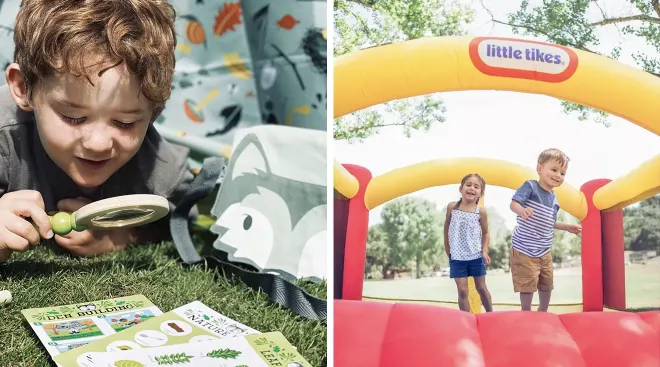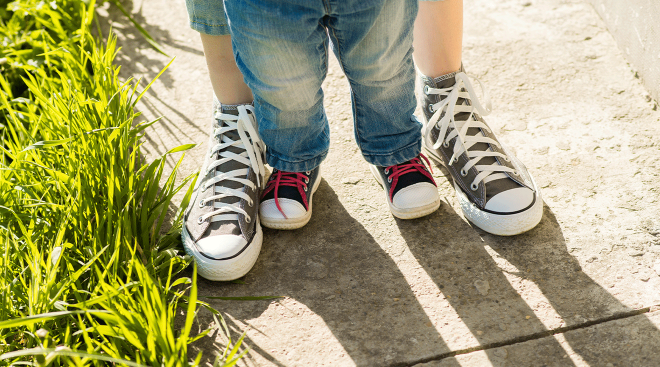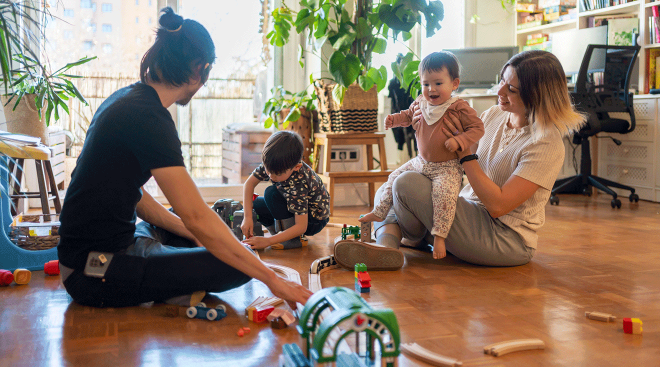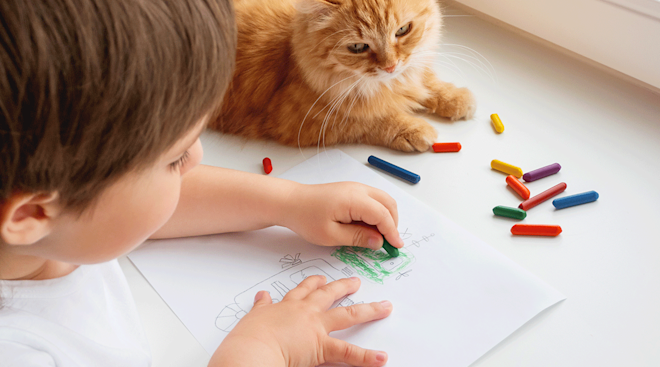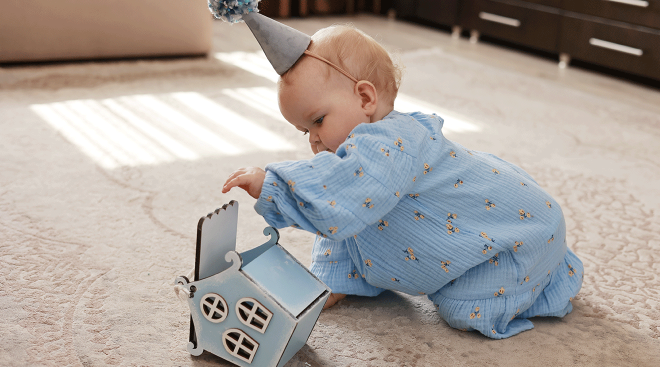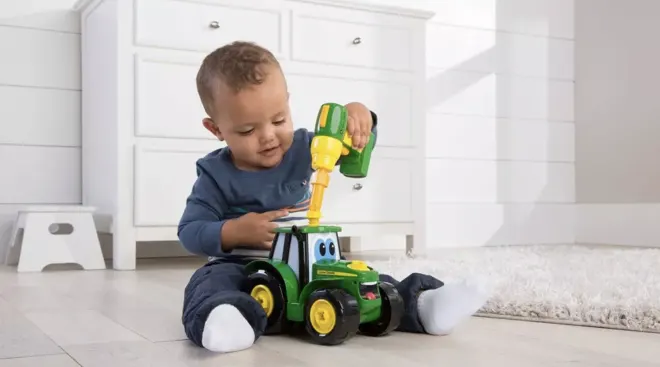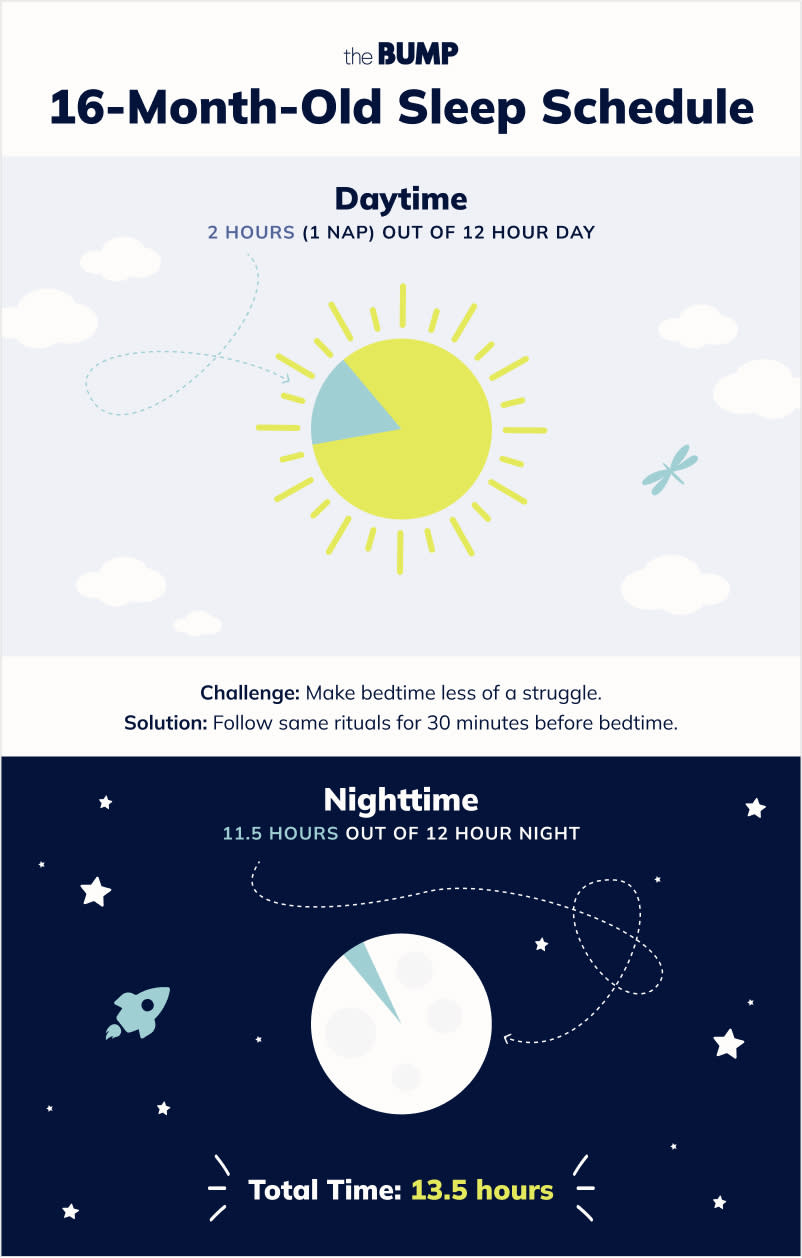Your 16-month-old is probably in a state of constant motion, playing, kicking, walking, climbing—maybe even running. If you have a climber, it’s time to triple-check the childproofing throughout your home. It’s also a good idea to keep a rug or carpet beneath the crib in case of jailbreaks.
While your 16-month-old is keeping you on your toes, they continue to grow and make developmental leaps and bounds.
16-month-old weight and height
How much should a 16-month-old weigh and measure? According to the World Health organization, the median weight of a 16-month-old is 21.6 pounds for girls and 23.2 pounds for boys. The median height is 30.9 inches for girls and 31.6 inches for boys.
16-month-old milestones
- Walking. Most 16-month-olds are walking well, which is the lead-up to next steps: climbing, running, walking backward and dancing to music.
- Speech. About half of toddlers at this age are saying at least three words.
- Teething. As early as 16 months, your child’s cuspids or canines—the third bottom tooth from the front—may begin to erupt causing some teething pain.
- Potty Training. You can continue to "talk up" the potty and what people do there—but no pressure to potty train just yet. Your tot may start to notice it or even ask to sit on a potty chair. But it's okay if they’re not really interested just yet. One medical study suggests beginning between 27 and 32 months.
What should a 16-month-old be able to do?
When it comes to 16-month-old milestones, you’ll notice that your child is a little mover and shaker and has become your little shadow. Now that they can move around, they’ll be wanting to participate in everything you do, from cooking to working to joining you in the bathroom. You’ll start to see a new confidence emerge in your little one, which can be both exciting and unnerving. Expect some chattering (whether you can understand it or not) and lots of intentful observing and listening—so be careful what you do and say around your mini copycat!
Your 16-month-old may be exhibiting some challenging and boundary-pushing behaviors. Tap below for advice on dealing with:
How can you discipline a 16-month-old?
At this age, your 16-month-old still doesn’t always understand what is and isn’t acceptable behavior. Your best bet is to set a good example and reward positive behavior. While tantrums are one of the 16-month-old milestones you’d probably rather skip, they are par for the course. Try to redirect behavior and use clear and concise words to get your point across, like “no hitting” and “stop throwing.” Your 16-month-old may soon start to realize that their behavior impacts others, so they may try to comfort someone they’ve just hurt. Encourage this empathy.
Toddlers are constantly exposed to germs—and it doesn't help that their food and drink preference can lead to some digestive problems. Common health questions at 16 months are:
- My 16-month old has a fever. What should I do?
- My 16-month-old has diarrhea. What should I do? Could it be "toddler's diarrhea"?
- My 16-month-old has constipation. What should I do?
Your little one eats lots of different foods now, but it’s normal to still stress about whether they’re getting a balanced diet.
How much should my 16-month-old eat and drink?
Your 16-month-old should be eating three meals and two snacks per day. Doctors say most toddlers need approximately 1,000 calories per day—give or take—or about 40 calories for each inch of their height. If your child devours their food one day and barely touches it the next, that's totally normal. In fact, toddlers are excellent judges of just how much they should be eating. And remember: a serving of food for them is only about one-fourth the size of an adult portion. If your toddler isn’t already eating with a spoon and fork sometimes, encourage them to practice.
What to feed a 16-month-old
About two 8-ounce cups of whole milk per day is recommended for a 16-month-old. Aim for about 700 mg of calcium total per day. Give your child a regular open cup or a straw cup as much as possible. They should completely be off the bottle, and some doctors warn that sippy cup use (with milk or juice) could lead to tooth decay and could inhibit speech development in some children.
Toddlers tend to get too little calcium, iron and fiber. In addition to dairy products, your child can get calcium from foods such as green leafy veggies, broccoli and tofu. Tofu can provide iron too, as can fortified cereal, dried peaches and lean ground beef. For fiber, you may offer pinto or refried beans, prunes, bananas and whole wheat pasta.
Your child should now be mostly off purees and other baby foods. Aim to feed the entire family well-rounded, unprocessed meals, and just mash and/or finely chop pieces for your toddler. Remember to also quarter any foods that are cylindrical and could be a choking hazard, such as grapes or a hotdog.
Food ideas for a 16-month-old:
16-month-old won’t eat
If your 16-month-old isn’t eating, it's likely just a case of picky eating. Continue to offer your child a variety of healthy foods for each meal and limit unhealthy treats. But don't start a power struggle over food. Here's more great advice on how to deal with picky eating. If your child won't eat anything at all, it could be a sign of illness, and you should call the pediatrician to discuss.
Feeding schedule for a 16-month-old baby
*A toddler's serving size is about ¼ of an adult's Source: HealthyChildren.org
You’ve been at this parenting gig for 16 months now, and sleep (for you and your tot) is still very much a priority. Here are some common bedtime questions and concerns.
How much sleep does a 16-month-old need?
One- to 2-year-olds need 11 to 14 hours of sleep total per day. Your 16-month-old may be starting to transition to just one nap per day, so your daily schedule might be doing a little bit of rearranging. Usually, it's the morning nap that goes, and either the afternoon nap becomes longer, or bedtime is a bit earlier. Luckily, this is usually a pretty natural transition.
16-month-old sleep regression
So, your 16-month-old won't sleep and you're desperate to make bedtime less of a struggle? For the 30 minutes before bedtime, follow the exact same rituals in the exact same order—and give your little one 20 minutes notice before they have to head off to bed. This parent trick for changing your kiddo’s bedtime has been shown to work: use the time they usually fall asleep naturally as your sleep routine starting point, then adjust it gradually, in 15-minute increments.
16-month-old sleep schedule
Here's one example of how it might go:
Playing with a 16-month-old is fun! They’re smart, savvy little creatures at this stage of toddlerhood, and they know how to have a good time. So what to do with a 16-month-old? Give them plenty of opportunities to enjoy the outdoors and discover the world around them. Playgrounds, parks and open areas offer ample opportunity for your toddler to explore. Also make sure you give your 16-month-old baby things to keep their hands busy. Whether they’re blowing bubbles, using finger paint or shaking a tambourine, let them practice the fine motor skills they’re actively mastering as they hit the 16-month-old milestones. Fun activities, games and toys for a 16-month-old include:
- Blocks. About half of 16-month-olds can make a tower by stacking three blocks.
- Coloring. Your toddler should also be able to scribble, so break out the sidewalk chalk and crayons (and hide all pens and permanent markers!).
- Pretend objects. Play kitchens, toy brooms and pretend phones allow a child to imitate what they’ve seen their parents doing.
- Teething pain? Let your 16-month-old snack on frozen peas—they feel good on gums and are surprisingly yummy, not to mention healthy.
- When you're changing your child's clothes, talk through what's happening. Soon, they'll be able to start doing this activity solo, and after that, they’ll learn to put clothes on.
- Have a dance party! Now that your child is fully mobile, they'll want to try out some new dance moves.
- Help your 16-month-old toddler develop their language skills by describing what they’re doing. Say things like, “I see you’re driving that truck under the bridge” or “look how carefully you’re putting your toys back into the box.” This helps them understand how words and actions go together. Also help by encouraging them to say what they want. Ask your child, “Do you want a banana or an apple for a snack?”.
- Give your toddler the words to describe emotions. (For example, “I see how happy holding that flower makes you” or “I feel sad that you hit me.”) This helps them name their feelings later and learn to show empathy.
- Let your 16-month-old build on their skills. Once they’ve reached one of their 16-month-old milestones, like stacking two blocks, encourage them to stack three! If your 16-month-old baby can toss a ball now, see if they can practice tossing it into a basket.
Your 16-month-old is the life of the party. They have strong emotions and let you know it. Lead by example; try to keep your cool when tantrums start and show positive reinforcement when they do a good job. This stage is full of excitement and exhaustion. You’ve got this!
Please note: The Bump and the materials and information it contains are not intended to, and do not constitute, medical or other health advice or diagnosis and should not be used as such. You should always consult with a qualified physician or health professional about your specific circumstances.
Navigate forward to interact with the calendar and select a date. Press the question mark key to get the keyboard shortcuts for changing dates.




































